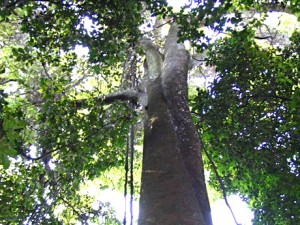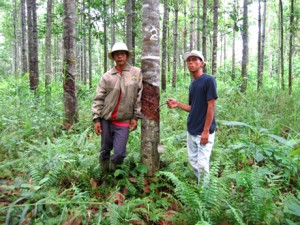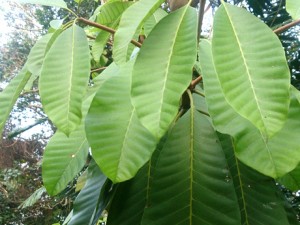Jelutong latex



Materials
- scientific name
- Dyera polyphylla (Miq.) Steenis.
Syn.:Alstonia polyphylla Miq., Dyera borneensis Baill., Dyera lowii Hook.f - general name
- Jelutong sawa (Jelutung sawa, Swamp Jelutung)
- overview
-
Jelutong is distributed in peat bogs and heath forests (kerangas), whose ground-water level is high, in areas such as Sumatra and Kalimantan in Indonesia, Sabah and Sarawak in Malaysia, and Brunei. It grows to as tall as 60 m. It has been excessively cut down for sawtimber and its latex has been collected as it is high in value. Therefore, the amount of the natural resource has decreased, and it is now classified as Threatened (vulnerable) by IUCN and extinction is feared in Sarawak. This species has less information on the resource’s actual conditions than D. costata, which is distributed more inland.
Fifty three percent of the world’s peat bogs are in Indonesia and Malaysia. As developing peat bog forests with drainage leads to enormous CO2 emissions, a policy to reduce the impact on climate change by rewetting peat bogs to control oxidation of peat has been implemented in recent years. Meanwhile, cultivation of this species is one of the most important candidates for means of livelihood for communities scattered around peat bogs as it grows in bogs without drainage and can produce latex, while there is little choice for non-timber forest production in bogs. It is expected that cultivation of this species in peat bogs and collecting and selling latex led by the communities will lead to preservation and restoration, and appropriate management of peat bog forests. Commercial afforestation of jelutong, creation of trial forests, and production of jelutong seedlings by communities have been started in Jambi, South Sumatra, and Central and South Kalimantan. In the past, latex used to be collected from large-diameter trees in natural forests, however in recent years, as the natural resources decreased, it is collected from planted trees with breast-height diameter of at least 15 cm, usually around 25 cm. A trunk thickens by about 1.7-2.4 cm a year, so it takes 10-15 years to grow to the size where latex can be collected. After collecting latex for 30 years, it is possible to cut it down and use as timber. Jelutong wood is cream-colored, straight-grained, and tsmooth-barked. It is used widely for furniture, and in sculpture, pencils, plywood, and pulp. It is said that manywild jelutong trees were cut down, causing a rapid decrease in the resource in and after the 1970s.
Natural material for chewing gums
When the trunk of a jelutong is damaged, milky-white sap exudes. Jelutong sap is of pH 4-5 and its moisture content is about 40%. The remaining solid portion consists of cis-isoprene polymer rubber, which accounts for 10-15%, triterpene ester resin, accounting for 40-60%, and the remainder is ash polysaccharides. However, it is said that the composition changes depending on the producing area and elasticity and flexibility change accordingly.
Product characteristics
- use
- Latex for chewing gum
- area
- Indonesia, Malaysia, Thailand
- overview
-
Export and import trends and demand in Japan
The import statistics of jelutong latex alone into Japan are unknown, however, looking at the import trends of “Natural rubber, balata, gutta-percha, guayule, chicle and similar gums; in primary forms or in plates, sheets or strip,” where jelutong is considered to be classified, it gradually decreased from 938 tons (440 million yen) in 2000 to 584 tons in 2005, 443 tons in 2010, and to slightly less than 139 tons in 2015 (170 million yen). Of the import amount as of 2015, about 88 tons are from Indonesia and about 44 tons are from Mexico. Products classified under that item name are not subject to duty. In the meantime, the production amount of chewing gum, where jelutong is primarily used, has been on a downward trend with 436 thousand tons in 2000, 443 thousand tons in 2005, 376 thousand tons in 2010, and 190 thousand tons in 2014. Nowadays, most chewing gum is made from plastics such as polyvinyl acetate and polyisobutylene.It is said that, in the 10-year period between 1996 and 2006, the annual production of jelutong latex amounted to about 600 tons in Indonesia and reached 800 tons in Central Kalimantan and South Kalimantan. Most of this jelutong latex is exported to Singapore and then to Europe and America, and supplied to gum manufacturers in Japan and South Korea. In the past, jelutong latex was exported directly from jelutong production companies in Central Kalimantan to Japan, but the companies failed to secure the necessary amount and the scheme hit a setback. The export value of Central Kalimantan reached 962 thousand USD in the 10-year period from 2002 to 2012, and that of South Kalimantan 166 thousand USD for the two-year period 2011-2012 (Indonesian government statistics). The price of jelutong latex is 20 USD or less per kilogram. In recent years, planting of jelutong has been moving forward in Jambi in Sumatra, and Kalimantan, and it is estimated that an annual amount of 1,500 tons can be produced and supplied in the next 10 years. Of global production of chewing gum, two multi-national corporations, Wrigley and Cadbury account for 60% (35% for Wrigley and 26 % for Cadbury), and Lotte 14%. The remainder is shared by 200-250 small chewing gum manufacturers.
Market prospects and issues to be addressed
Global total sales of chewing gum in 2012 reached 26 billion USD, showing a growth of 14% or more every year for the three-year period before 2012. The sales in America, the major consuming country, have remained stable at around two billion USD, indicating that there is a certain scale of stable market. From this perspective, it is conceivable that the prospects for jelutong latex production and sales are not necessarily pessimistic. However saying that, consumption of chewing gum is on a decreasing trend in Japan as mentioned above and it is assumed that there is a risk that the price would decline due to saturation of the market if production is expanded through creation of jelutong plantations in countries such as Indonesia. In order to reduce such risks, it is considered that developing products with added value in areas such as pharmaceuticals and diversifying its usage to products other than chewing gum are the issues to be tackled to promote forest preservation and restoration with jelutong as its core.
- references
-
- Hesti L. Tata, Bastoni, M. Sofiyuddin, Elok Mulyoutami, Aulia Perdana, dan Janudianto, 2015: Jelutung rawa -teknik budidaya dan prospek ekonominya, 62pp, World Agroforestry Centre (ICRAF)
- Wim Giesen, Euroconsult Mott MacDonald, 2015: Cultivation of Dyera polyphylla (swamp jelutung) Tanjung Jabung Timur District, Indonesia(1º20’S, 104º05’E), 4pp, FAO
- Hesti L. Tata . Meine van Noordwijk . Jasnari . Atiek Widayati, 2015: Domestication of Dyera polyphylla (Miq.) Steenis in peatland agroforestry systems in Jambi, Indonesia, Agroforestry systems, DOI 10.1007/s10457-015-9837-3
- http://www.iucnredlist.org/details/33243/0
- http://www.chewing-gum.org/
- http://www.statisticbrain.com/chewing-gum-statistics/


